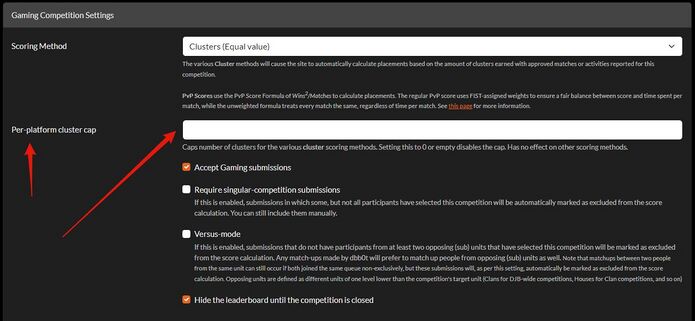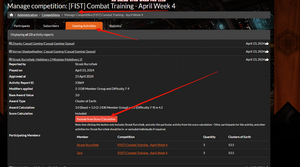This page lists the guidelines for creating and running gaming-based competitions for the Grand Master's Royal Guard (GMRG), non-GMRG Fist Office events and general gaming competitions.
Approval Process
For non-Rogue or non-Council members, all competitions will stop with your House or Clan summit for initial approval, including gaming competitions. We encourage members to first work with their Clan/House leadership before submitting any competitions, including gaming or gaming-related competitions. Gaming competitions submitted by Rogue or Dark Councilor members will go directly to the Fist Staff, followed by the Master at Arms.
Gaming or Bracket Archetype Approval Process:
Clan/House Leadership -> Fist Staff -> Master At Arms Staff
The “Competition Type” field (after selecting a competition archetype) is what governs whether or not a competition will stop with the Fist Office for approval before final approval by the MAA Staff. Only the following competition types will stop with the Fist Office:
- MMO Gaming/TOR
- Multiplayer Gaming
- Multiplayer Ladder
- Single-player Gaming
You will notice that “Flash Gaming/Puzzles” are not on this list. These competitions will not stop first with the Fist Office and will go from your Summit directly to the MAA or directly to the MAA if you are Rogue or a Councilor. However, this guide can still provide insight on running a successful Flash Gaming competition as many of the same elements are required for Flash or browser-based gaming as it is for the other gaming categories.
Required Elements
Competition Archetype
The scoring criterion you end up using will vary greatly based on the Competition Archetype that you choose. Gaming competitions generally fall within one of the following four options:
 The Archetype selection when first creating a competition
The Archetype selection when first creating a competition
- Gaming Archetype aka Cluster Race - allows participants to submit activity through the regular Gaming Activity submission forms. The competition organizer can then verify these submissions, after which the site automatically scores the participants based on a number of configurable metrics.
- Bracket Archetype - allows organizing knockout-tournament style competitions. It acts as a container-type competition one or more sub-competitions that are usually set to not award crescents. People can subscribe to the container/bracket but not submit to it.
- Regular Archetype - provides functionality for participants to subscribe to the competition and submit their entries through the site without any additional functionality. Unlike the first two, you will need to put thought into your own grading and scoring of competitions in this Archetype.
- Timed Archetype - can be used to measure the interval between the moment a participant subscribes to a competition, and the moment they submit, for example in case of Trivia-like competitions. This competition archetype does not allow subscribers to unsubscribe from the competition. Similar to the Regular Archetype, you will be required to grade and score a Timed gaming competition manually.
Clear Scoring Criteria and Tie Breakers
This is perhaps the most important aspect to any competition and where you are most likely to run into trouble with your competition. Your gaming competition should always have clear, unambiguous scoring criteria, including tiebreakers.
For the Gaming Archetype, our website is able to auto-score based on the following criterion:
- PvP Score and Weighted PvP Score - Neither of these types should be used. PvP score and weighted PvP score are no longer used in the Brotherhood.
- Clusters (CF worth 2 CE) - Assigns points to participants based on the clusters they have earned towards the competition. A Cluster of Fire is worth two Clusters of Earth using this method which means that time spent in PvP or PvO activities would generally have a higher value for final placement.
- Clusters (Equal Value) - In this methodology, both CFs and CEs have the same value. This method would be used if you do not want to give added weight to PvP or PvO activities for final placement.
- Clusters (CF Only) - Use the methodology if you only want placements decided by PvP activities. Any PvE activities would not count towards final placements.
- Clusters (CE Only) - Use the methodology if you only want placements decided by PvE activities. Any PvP activities would not count towards final placements.
- Sum of quantity - This methodology counts the number of activities and not the amount of clusters earned for said activities. Using this methodology negates the Cluster modifiers set up by the Fist office and is a very rarely used method of scoring.
 The Per-Platform cluster cap can be found under Gaming Competition settings when creating a Gaming Archetype Competition
The Per-Platform cluster cap can be found under Gaming Competition settings when creating a Gaming Archetype Competition
Another scoring option for the Gaming Archetype (cluster race) is the “Per-platform cluster cap”. This puts a cap on the number of clusters per platform that will count toward a cluster race. Basically this limits the amount of points a member can gain for the competition from a single game.
 Particular gaming submissions can be excluded from scoring by the competition organizer by going to the gaming activities tab while managing the competition.
Particular gaming submissions can be excluded from scoring by the competition organizer by going to the gaming activities tab while managing the competition.
It is the responsibility of the competition organizer to verify all gaming submissions meet the criteria for the competition. For example, if a member runs a “Star Wars games only” cluster race then it is the responsibility of the competition organizer to go into the "Gaming Activities" tab of the manage competition menu to exclude gaming submissions that are not Star Wars games. The Fist staff only validates gaming submissions to see if they are valid for clusters, they do not enforce particular cluster race rules. That is why competition organizers get credits and XP.
For the Bracket Archetype, scoring should be based on placement within the bracket itself.
For gaming competitions within the Regular or Time Archetype you will need to put significant thought into the scoring methodology you plan to use. This includes adding AT LEAST one tie-breaker, with a second level tiebreaker being highly encouraged. In most cases, your initial scoring criteria will be either a high score or attaining a certain level. Your second level should ideally be a factor not tied directly to the primary scoring options you chose. NOTE: First overall to submit is highly discouraged as a tie breaker. This is referring to using the start of the competition as the point of reference and no the members time from subscription in a Timed Archetype.
For example, if I choose the number of shotgun kills in Platform A PvP matches as my primary scoring methodology I would not want to choose the number of overall kills as my tiebreaker as those two are very closely related and the chances for a second-level tie are pretty good. Instead, I could choose a metric not directly related to kills such as capture points taken or players revived.
When using the Timed Archetype, the timed portion of the competitions should always be used, even if only as a tiebreaker. For example, first to complete the final level of a game with a tiebreaker of first to submit from their initial subscription to the competition. To avoid any issues with competition approval, the scoring methodology should not be in the hidden prompt. This doesn’t allow members to assess if they have the time to fully complete the requirements when they subscribe to the competition.
Example Screenshot
When hosting a competition archetype that does not have an auto-grading element, it is required that you attach a screenshot of what you expect participants to submit for placement. If you are using a hidden prompt on a timed competition, place this screenshot link within the hidden prompt along with the directions.
GMRG Notification
The Fist Office hosts a monthly series of competitions that provide points for the Grand Master’s Royal Guard Leaderboard. If you are a member of the Fist Office and are submitting a competition towards this series, please add the following to the scoring criteria:
Placement in this competition will be included in the GMRG score calculation for members that are Rank VI and above.
If you are not a member of the Fist Office, do not include this wording.
Suggested Elements
Rights of Combat (RoC) Reminder
Although not explicitly required it is a very good idea to include a reference to follow the RoC. In particular, clan feuds, coop events or vendettas have special rules in the RoC. A reminder is always a good idea especially as the more visible a competition becomes the more likely members who are not as familiar with the requirements our gaming community will participate.
Information About the Platform
Adding background about the gaming platform or the specific mode within the platform that the competition revolves around can be very helpful. Members who are very active on the platform that you are designing your competitions around likely will not need this background but providing this information can help pull in other members.
This background information can range from a short paragraph explaining the platform and/or mode or you can link to guides. For example, this 2019 The Old Republic competition revolved around the Conquest system. It included an outside link to a guide about the Conquest system within the platform.
General Competition Ideas
While this is not an exhaustive list of gaming competitions types, the list included in this guide is a great place to start. As you become more well versed in both hosting competitions and in a gaming platform you will likely be able to brainstorm additional ways to engage members.
Cluster Race
Cluster Race (Gaming Archetype) uses the cluster submission process to score the competition so generally the more gaming clusters one submits to the competition the higher the score. Cluster races are easy to participate in through casual queue and pazaak but require a great deal of effort to win especially in larger competitions. This can become grindy and induce burnout in large events. For long events such as a vendetta it’s best to consider breaking the cluster races up into smaller competitions like weekly races. Also competition organizers can put additional requirements on cluster race such as only submissions for a certain game, or only cross-clan group submissions will be accepted. Reach out to the Fist staff if you want to run a cluster race with restrictions.
Score Based
Score based, also sometimes referred to as skill based, competitions are very popular because of two factors. The first is they should generally have a low barrier to participation. The second is that they don’t require an endless grind in order to win.
The low barrier to participation is a result of these competitions, in many cases, allowing or even requiring no other club members in your match. Also, since they are based on a quantitative metric within the platform of choice members are able to simply perform to the best of their ability and then choose their submission from their best overall performance to win. If someone excels at a certain game, they could theoretically have the winning entry on their first attempt.
An example of these types of competition is the May 2020 GMRG competition for healer challenge in Heroes of the Storm. Since this is not an automatically scored competition, the competition host set multiple tie breakers and also mentioned that another club member must be in the competition. Allowing or encouraging fellow club members allows for someone to form a group to try to pump up their score. If the host chose to, they could have restricted it so that other club members were not allowed and eliminate that strategy. There isn’t a right or wrong answer but be aware of what you are or are not allowing when you set your competition up.
Level Based
These are similar to the score based competitions but instead will ask members to progress to and beat a specific level within a game. These are very popular with mobile gaming competitions. But be warned, more than one person will DEFINITELY get to the final level. You may think the game is so hard that there’s no way it is possible but I assure you that it is and my claim is backed up by club history.
If you are using the highest level beaten as the first scoring criteria you are suggested to have at least one additional tie breaker and then also use the Hidden Archetype so you can add submission time as the third tie breaker. Hosting a level based competition can be very tricky, think through your tiebreakers very thoroughly.
Although this guide is not specifically addressing Flash or browser gaming, these competition types frequently share the same concerns and pitfalls listed above.
Competitions for Non-Supported Platforms
While there is not an explicit ban on hosting a competition for games that are not officially supported by the club, these events will see an increased level of scrutiny from the Fist Office. The factors that the Fist Office will consider when reviewing competitions for non-supported platforms are:
- Cost of the game, especially in relation to its age. $50 games that are a decade old could be a bad idea.
- Recent interest within the DJB. A game that has some buzz around it is likely a better idea than one that isn’t getting much attention.
- Is your competition part of a larger series? These types of competitions might be best run standalone, especially if there is no history of the game you are using seeing a high volume of submissions.
- If your platform is one with interest limited mostly to your unit or sub-unit, consider limiting the scope of the competition to that unit as well.